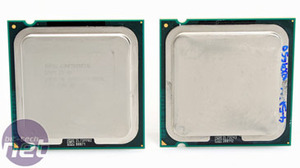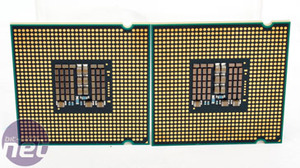Intel Core 2 Extreme QX9770
Manufacturer: IntelUK Price (as reviewed): £903.87 (inc. VAT)
US Price (as reviewed): $1677.43 (ex. Tax)
We've finally hit 1,600MHz FSB. Wow. While not super revolutionary like its "Extreme" predecessor, the QX9650, the QX9770 attempts to drag the performance bar up to a new level.
How exactly? Well, while Intel enjoys its pedigree in innovation and as it rolls in the warm yellow glow of the Penryn architecture, the QX9770 is literally back to the old school “make it all faster” approach. We now have a 200MHz faster core – at 3.2GHz (8x400MHz) this is the fastest Core 2 processor to date, and also a new 1,600MHz quad-pumped front side bus, up from the now ‘out of date’ 1,333MHz FSB.
Sadly, this will be the last ever “front side bus” speed hike, ever! The antiquated architecture is due for a complete culling when Nehalem arrives with its fancy pants QuickPath interconnect and integrated memory controller.
The new front side bus also means that the Intel X38 and X48 chipsets should also now utilise a 1,600MHz DDR3 memory clock – the fastest clock officially sanctioned by JEDEC. So, with faster CPU, bus and memory clocks – that’s all good, right? But as Intel’s “Extreme” product it also commands an “Extreme” price-tag of over £900 (inc. VAT) and often a “special order only” attachment.
Regardless of whether you can afford this or not, you can always buy a Q9450 (8x333MHz) for a fifth of the price and just crank up the bus from 333MHz to 400MHz. What does the performance increase represent?


I can haz identikal? That's why we mark them in pen to make it easier to tell – re-installing the Thermalright Ultra 120 eXtreme is a pain in the backside! The QX9770 is on the left just in case you can't quite read my shoddy "45nm QX9650" handwriting on the right.

Click to enlarge
Overclocking (to) the Extreme?
We’d expect these parts to be the mutts nuts of CPU cores – purposely picked by Intel for its premium chips. Do these clock any higher than normal? As the DDR3 bus is already quite strained at 1,600MHz, dropping that down and using the unlocked multiplier in addition to a touch extra front side bus will certainly aid overclocking.In this respect an X48 board, while not inherently different to X38, is the perfect (expensive) partner because it should offer more BIOS options. While I won’t get started on Intel’s idea of an “enthusiast” having deep pockets rather than our idea of an “enthusiast” getting maximum value for money—that’s another article entirely; if you’re in the market for the most expensive hardware you shouldn’t be half baked.
The CPU will easily get to 4GHz, but our part would require some considerable voltage bump to get it stable at what is just an 800MHz hike. While 1.35-1.4V doesn't sound like a lot when we think of Core 2 processors, even with a Thermalright Ultra 120 eXtreme and two fans strapped to either side we were still getting significantly higher temperatures than we had experienced at stock values. Further pushing just exasperated the problem we found ourselves hitting ~1.45V and 80˚C when we turned it up to 4.4GHz (11x400, multiplier adjusted). Double check the hold down, double check the thermal paste, reseat the cooler, check the fans, reseat the CPU... nothing helped.
It did try to boot Windows, but the poor thing was just got too hot under the collar. Some serious cooling for a serious CPU is needed, well, at least for our part. By comparison, our QX9650 seems to be a better chip, and it's also considerably cheaper. We've managed to get that happily churning out Prime95 numbers on all cores at 4.35GHz for hours without overheating nearly as badly.
As is always the case with overclocking, it's not "you get what you pay for" it's merely "luck of the draw" – Intel certainly guarantees nothing in this respect.

MSI MPG Velox 100R Chassis Review
October 14 2021 | 15:04









Want to comment? Please log in.